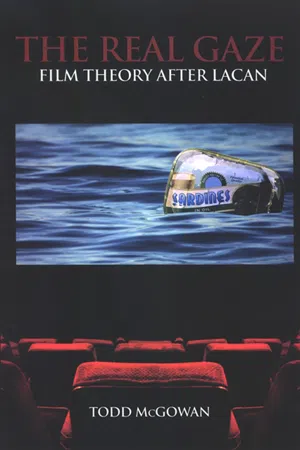
- 266 pages
- English
- PDF
- Available on iOS & Android
About this book
Examines the gaze in Lacanian film theory.
Winner of the 2008 Gradiva Award, Theoretical Category, presented by the National Association for the Advancement of Psychoanalysis
The Real Gaze develops a new theory of the cinema by rethinking the concept of the gaze, which has long been central in film theory. Historically film scholars have located the gaze on the side of the spectator; however, Todd McGowan positions it within the filmic image, where it has the radical potential to disrupt the spectator's sense of identity and challenge the foundations of ideology. This book demonstrates several distinct cinematic forms that vary in terms of how the gaze functions within the films. Through a detailed investigation of directors such as Orson Welles, Claire Denis, Stanley Kubrick, Spike Lee, Federico Fellini, Ron Howard, Steven Spielberg, Andrei Tarkovsky, Wim Wenders, and David Lynch, McGowan explores the political, cultural, and existential ramifications of these differing roles of the gaze.
Frequently asked questions
- Essential is ideal for learners and professionals who enjoy exploring a wide range of subjects. Access the Essential Library with 800,000+ trusted titles and best-sellers across business, personal growth, and the humanities. Includes unlimited reading time and Standard Read Aloud voice.
- Complete: Perfect for advanced learners and researchers needing full, unrestricted access. Unlock 1.4M+ books across hundreds of subjects, including academic and specialized titles. The Complete Plan also includes advanced features like Premium Read Aloud and Research Assistant.
Please note we cannot support devices running on iOS 13 and Android 7 or earlier. Learn more about using the app.
Information
Table of contents
- The Real Gaze
- Contents
- Preface
- Acknowledgments
- Introduction:From the Imaginary Look to the Real Gaze
- Part 1. The Cinema of Fantasy: Exposing the Excess
- Part 2. The Cinema of Desire: Absence amid the Plenitude of the Image
- Part 3. The Cinema of Integration: The Marriage of Desire and Fantasy
- Part 4. The Cinema of Intersection: Collisions of Desire and Fantasy
- Notes
- Index